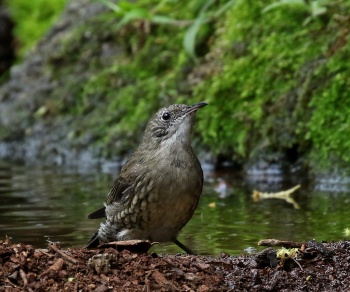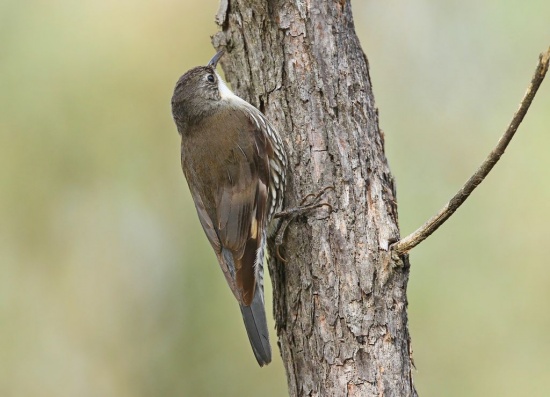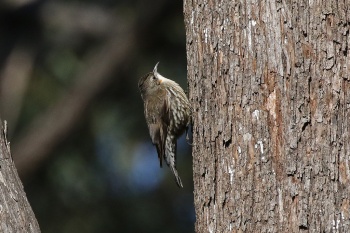Alternative name: Little Treecreeper (minor)
- Cormobates leucophaea
Cormobates leucophaeus
Identification
14-16.5cm (5½-6½ in)
- Dark brown upperparts
- White throat and chest
- White streaks on flanks edged with black
- Contrasting grey rump and tail, tail with black subterminal band
- Broad rufous-buff bar on wings, visible in flight
- Barred undertail
Females have an orange mark on the sides of the face.
Juveniles have blackish-edged dull white shaft streaks on scapulars, fine grey scaling on upper breast and a strong cinnamon-brown wash on undertail-coverts and sometimes abdomen.
Distribution
South-eastern and southern mainland Australia.
Common in most of its range.
Taxonomy

Photo by Hans&Judy Beste
Yarraman State Forest, Queensland, March 2018
Formerly considered conspecific with Papuan Treecreeper.
Subspecies
Five subspecies recognized[1]:
- C. l. minor:
- Northeast Queensland (uplands of Cooktown, Atherton and Paluma)
- C. l. intermedia:
- Eastern Queensland (Clarke and Connors Ranges)
- C. l. metastasis:
- Eastern Australia (Fitzroy Range, Queensland to Hunter Range, New South Wales)
- C. l. leucophaea:
- Southeast Australia (central New South Wales to southern Victoria and southeast South Australia)
- C. l. grisescens:
- South Australia (Mount Lofty Range)
Habitat
Rainforests, woodlands and timbered river areas.
Occurs also in selectively logged areas and in small isolated forest remnants but absent or rare in clear-felled or heavily cattle-grazed areas.
In lowlands and lower highlands, minor at 300 to 1200m.
Behaviour
Diet
Feeds on insects, mainly ants. Takes also spiders and sometimes sap from eucalypts or acacias and rarely nectar.
Forages by gleaning and probing on bark of trees and shrubs, as well as logs. Rarely on ground.
Breeding
Breeding season from August to January, normally single-brooded. A monogamous species.
The nest is a cup-shaped structure made of bark fibres, grass and moss. It's placed in a tree hollow or a crack in side of a limb or in the end of a broken limb. Breeds sometimes in nest boxes. Lays 2 to 3 eggs.
Movements
A sedentary species.
References
- Clements, J. F., T. S. Schulenberg, M. J. Iliff, D. Roberson, T. A. Fredericks, B. L. Sullivan, and C. L. Wood. 2018. The eBird/Clements checklist of birds of the world: v2018. Downloaded from http://www.birds.cornell.edu/clementschecklist/download/
- Del Hoyo, J, A Elliott, and D Christie, eds. 2007. Handbook of the Birds of the World. Volume 12: Picathartes to Tits and Chickadees. Barcelona: Lynx Edicions. ISBN 978-8496553422
Recommended Citation
- BirdForum Opus contributors. (2024) White-throated Treecreeper. In: BirdForum, the forum for wild birds and birding. Retrieved 26 April 2024 from https://www.birdforum.net/opus/White-throated_Treecreeper
External Links
Search the Gallery using the scientific name:
GSearch checked for 2020 platform.1






